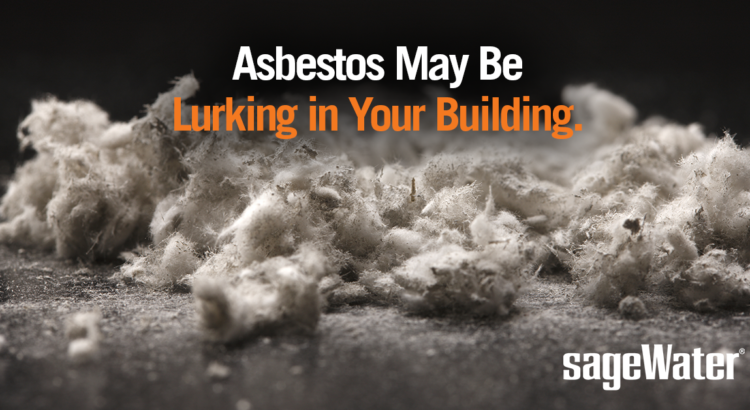Asbestos May Be Lurking in Your Building. Take a Strategic Approach That Protects People’s Health and the Bottom Line.
If you own, manage, or operate older multifamily buildings, thinking about asbestos is inevitable. Even so, we at SageWater encounter many misunderstandings among our clients about when and how to test for asbestos in their buildings. We recommend that a well-run apartment building and community association will perform a proactive building inspection, which enables them to protect people’s health and the bottom line.
Why asbestos inspections matter
As many people know, asbestos fibers are carcinogenic and extremely hazardous to anyone who inhales them, which can happen when asbestos-containing materials (ACM) are disturbed. Though asbestos has been banned from most manufacturing for decades, it still exists in several products installed in older buildings such as pipe insulation, drywall joint compounds, fire-resistant drywall, floor tiles, and much more.
To prevent asbestos exposures, multifamily owners and operators are required by federal law to inspect their buildings before construction, demolition, and renovation activities. Believe it or not, this requirement is for every multifamily community with more than 4 units, no matter how old, and it means considering ACM before conducting some maintenance repairs. This can surprise people who expect the law applies to only older buildings. Perhaps the confusion comes from regulations stated by the Department of Labor that for buildings constructed before 1981, you must presume that thermal system insulation and surfacing material contain asbestos until an inspection is conducted. In any case, the federal law applies and state and local regulations may be even more stringent.
Of course, complying with the laws—including those regarding handling and removal of asbestos—protects the health of contractors, maintenance staff, residents, and even waste management workers who handle debris. Compliance also means that building owners, operators and contractors avoid hefty fines and lawsuits. Just last July, for example, the Department of Labor cited three companies with proposed penalties of more than $230,000 for exposing their workers and the residents of a Missouri nursing home to asbestos when replacing a floor.
Other common misunderstandings about asbestos testing
For renovations like a SageWater repipe, our clients are usually aware that an asbestos survey is required. They may, however, underestimate the range of materials that contain the hazardous material. In these cases, the documentation they have from previous assessments may not be adequate.
Sometimes, our clients may think that they don’t need to test for asbestos because they conducted a Phase I Environmental Site Assessment before purchasing their property and the ESA did not reveal asbestos concerns. In fact, an ESA does not include an asbestos assessment unless the client specifically requested one. Even then, the findings reflect only the scope of the request, which may not cover the materials impacted by our repipe project.
Poor or non-existent maintenance protocols
We may also observe that multifamily owners and managers don’t have good governance—or any governance—regarding asbestos inspections for day-to-day maintenance and repairs. Even the most fastidious managers might forget about asbestos when called on to make emergency repairs—such as replacing a section of leaking pipe behind a wall or under a floor. Afterall, speed can be essential to limiting the total cost of damages and repairs. But mishandling ACM that’s found to contain dangerous levels of asbestos can open owners and employers to legal liability.
For times like this, we suggest that you presume asbestos is present and act accordingly. Better yet, get ahead of future problems and follow Environmental Protection Agency (EPA) guidance to develop and maintain an Operations and Maintenance (O&M) program.
A couple of key O&M program benefits
One of the first steps the EPA defines for an effective O&M program is to appoint an Asbestos Program Manager (APM) to your staff who can, “oversee all asbestos-related activities in the building, including inspections, O&M activities, and other abatement actions”. The APM will train or else ensure training for building workers in O&M techniques. This reduces your need to outsource accredited services for some maintenance and repair that involves ACM.
Another benefit of the EPA-defined O&M program is that you’ll obtain a building inspection that provides an inventory of asbestos-containing material and an assessment of the ACM’s condition and potential for disturbance. A thorough report will not only inform your maintenance plan, it may eliminate the need to conduct ad hoc inspections for larger, more intrusive renovation projects like a repipe.
You’ve heard the adage: an ounce of prevention is worth a pound of cure. Don’t wait until your next renovation or—even worse—your next emergency repair to find out if you may be putting workers or residents at risk of asbestos exposure. Act now to protect people and the bottom line. Obtain a building inspection today from a trained and accredited asbestos inspector.
Sources:
- US EPA Information for Owners and Managers of Buildings that Contain Asbestos
- US Department of Labor Occupational Safety and Health Administration Regulations, Standard Number 1910 Subpart Z – Toxic and Hazardous Substances 1910.1001 – Asbestos
- Overview of the Asbestos National Emission Standards for Hazardous Air Pollutants (NESHAP)


